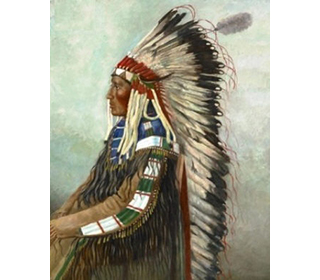There were several different types of headdresses worn by different Native Indian tribes including the long, trailing feather headdresses worn by the Sioux and the Cheyenne, the straight-up headdress worn by the Kiowa and the Comanche, the halo feather headdresses worn by the Hidatsa tribes and the Blackfoot and the feather crowns and plumes worn by the Californian Shasta and Chumash Tribes. Feather Headdresses Fact Sheet - Feather Headdress Fact 1: Tribes would often adopted several different styles of headdresses
- Feather Headdress Fact 2: The trailing war bonnet featured either a single or double rows of feathers that extended all the way down to the ground
- Feather Headdress Fact 3: The halo war headdress was so-called because the feathers fanned out around the face and shoulders of the wearer
- Feather Headdress Fact 4: The straight-up feather headdresses were the tallest in which eagle feathers were made to stand up straight, hence the name
- Feather Headdress Fact 5: The crown and plume are the least known style of headdress consisting of a complex flicker feather headband, a feather crown and a tall plume
- Feather Headdress Fact 6: The purpose and the symbolic meaning of the different feathers that were used varied from tribe to tribe
- Feather Headdress Fact 7: Feathers were perceived by Native American Indians as gifts from the sky, the sea and the trees
- Feather Headdress Fact 8: A feather was believed to possess supernatural powers that empowered the wearer with the powerful traits and characteristics of the bird
- Feather Headdress Fact 9: A feather from an eagle was the most powerful and symbolized great strength, courage and prestige. The bald eagle and the golden eagle were considered the most sacred of birds
- Feather Headdress Fact 10: The Meaning of feathers: Different types of feathers represented different meanings. Crow feathers represented skill and cunning, Eagle feathers indicated great strength and courage, Falcon feathers represented speed, Hawk feathers represented strength and vision, Hummingbird feathers indicated intelligence, Owl feathers (wisdom) and Raven feathers (creation & knowledge)
- Fact 11: The significance of a headdress would be judged from the feathers attached to it
- Fact 12: Not every Native Indian was allowed to wear such a headdress. Only was awarded to warriors who had displayed great acts of bravery in battle were allowed to wear this type of regalia
- Fact 13: A headdress would be presented to a warrior in a an elaborate and highly ritualized ceremony
- Fact 14: A headdress would also consist of other valuable adornments such as ermine skin, shells, buffalo hair, hawk bells, quills and beads
- Feather Headdresses Fact 15: Dyes were often used to color the feathers
- Fact 16: The style of headdress and other clothing were decorated in a distinctive manner to identify one tribe from another
- Fact 17: Every feather in the headdress was a symbolic reflection of brave deeds. The braver the warrior, the greater number of feathers
- Fact 18: Some warriors had only two or three feathers in their headdresses throughout their life time
- Fact 19: Black Hawk, the famous leader of the Sauk and Fox tribes killed his first opponent at the age of 15 which allowed him to wear war paint and feathers with permission of the tribal elders
- Fact 20: An elaborate headdress would generally only be worn during special ceremonies and rituals, a long trailing war bonnet would be highly impractical during battles. A Roach headdress would therefore often be worn instead
|
